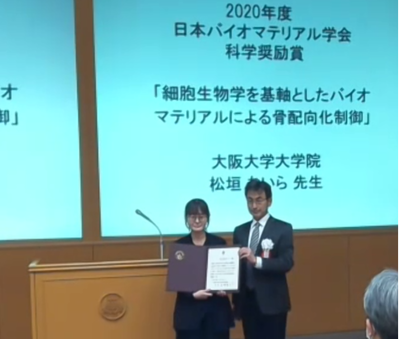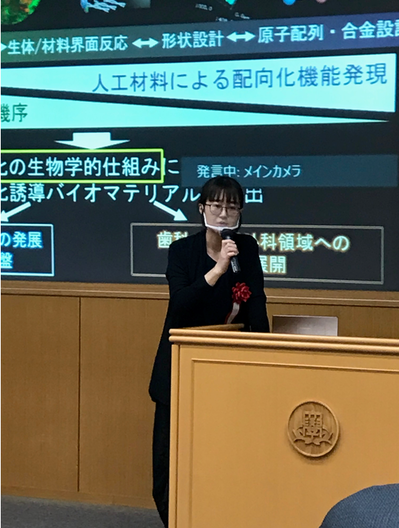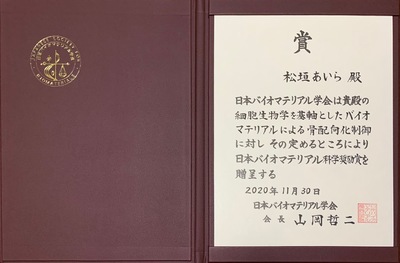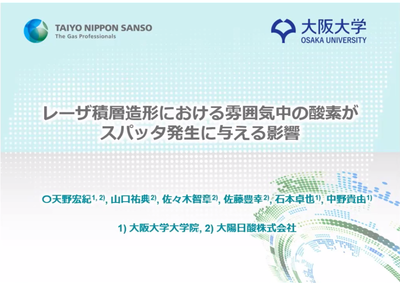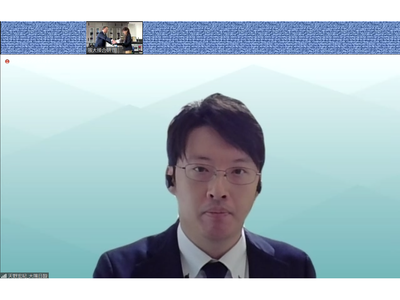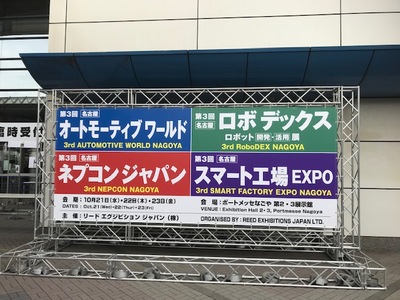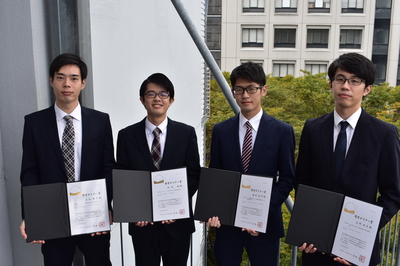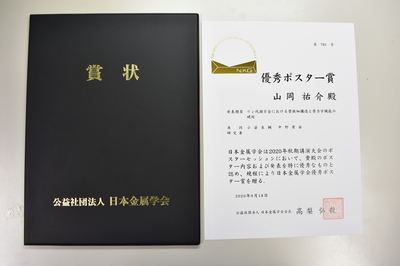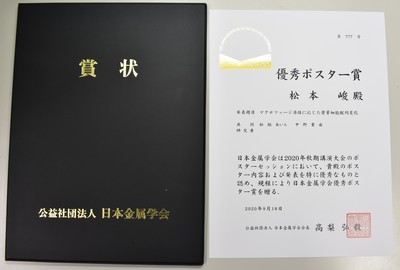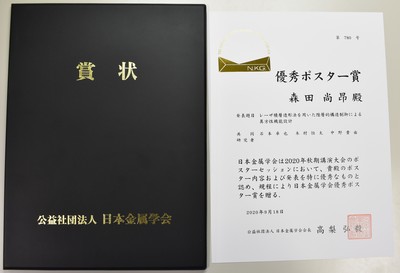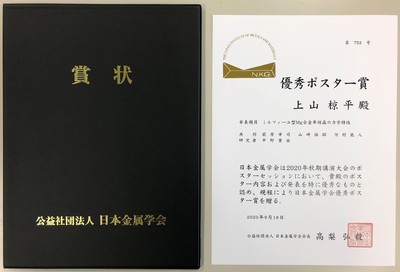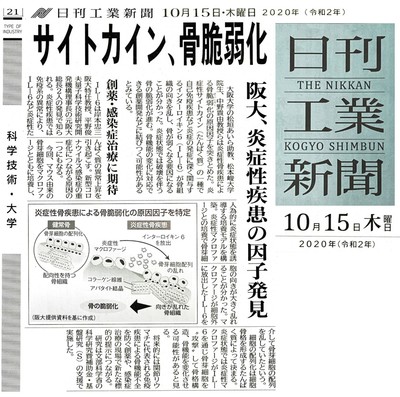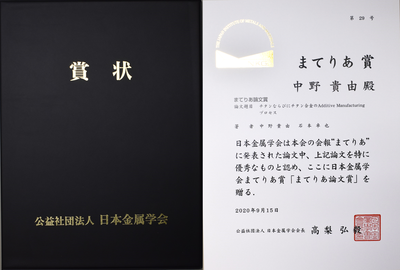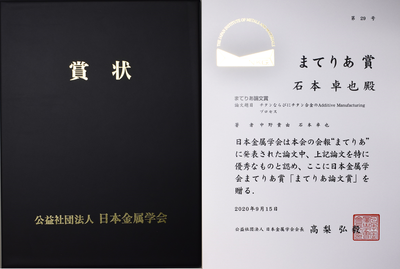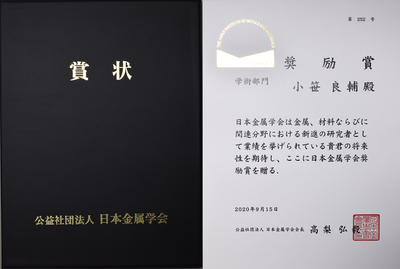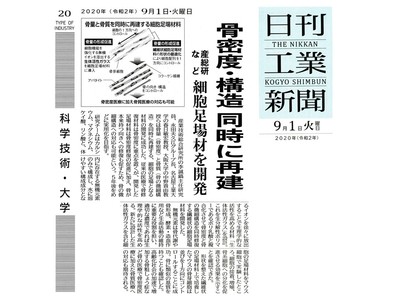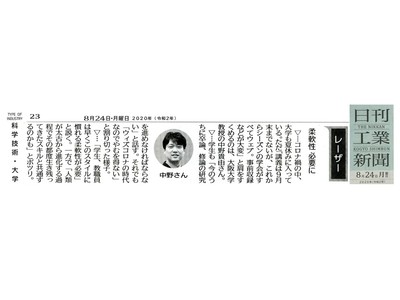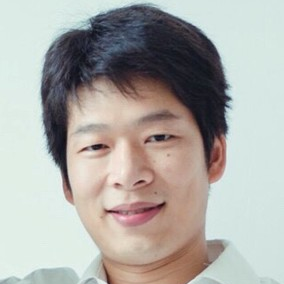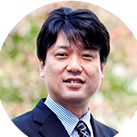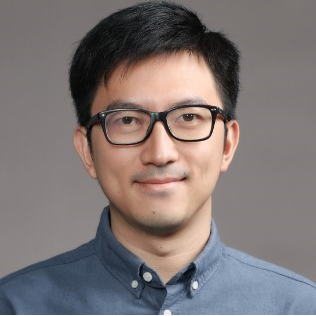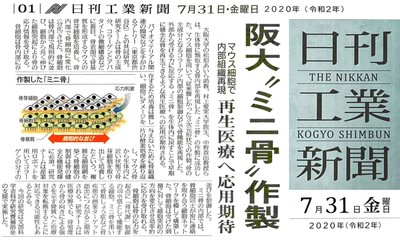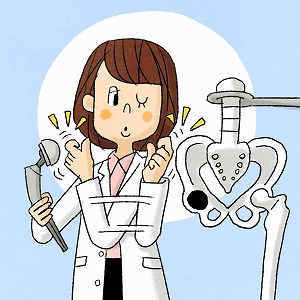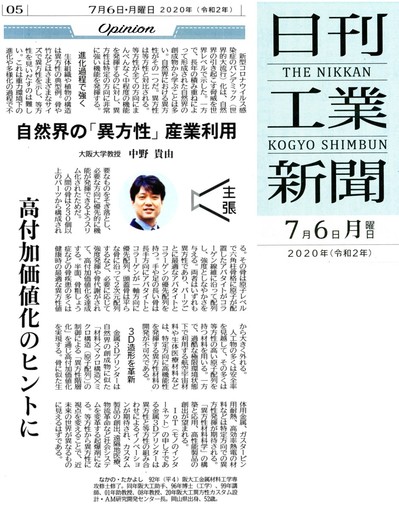What's New
2020(July-December)
-
2020.12.30
-
2020.12.13
-
2020.12.8
-
2020.12.1
-
2020.11.30
-
2020.11.27
-
2020.11.12
-
2020.11.8
-
2020.11.7
-
2020.11.5
-
2020.11.5
-
2020.11.1
-
2020.10.30
-
2020.10.28
-
2020.10.22
-
2020.10.22
-
2020.10.17
-
2020.10.15
-
2020.10.12
-
2020.10.2
-
2020.10.1
-
2020.9.30
-
2020.9.23
-
2020.9.18
-
2020.9.16
-
2020.9.15
-
2020.9.12
-
2020.9.11
-
2020.9.8
-
2020.9.3
-
2020.9.3
-
2020.9.1
-
2020.8.24
-
2020.8.13
-
2020.8.12
-
2020.8.12
-
2020.8.10
-
2020.8.6
-
2020.8.1
-
2020.7.31
-
2020.7.30
-
2020.7.30
-
2020.7.30
-
2020.7.29
-
2020.7.27
-
2020.7.11
-
2020.7.6
-
2020.7.3
-
2020.12.30
A collaborative research paper with Dr. Ebina of the Department of Orthopaedic Surgery, Osaka University, has been published as an open access article in the International Journal of Molecular Sciences.
Gensuke Okamura, Kosuke Ebina*, Makoto Hirao, Ryota Chijimatsu, Yasukazu Yonetani, Yuki Etani, Akira Miyama, Kenji Takami, Atsushi Goshima, Hideki Yoshikawa, Takuya Ishimoto, Takayoshi Nakano, Masayuki Hamada, Takashi Kanamoto, Ken Nakata:
Promoting effect of basic fibroblast growth factor in synovial mesenchymal stem cell-based cartilage regeneration,
International Journal of Molecular Sciences, 22, (2021), 300: 1-16.
https://doi.org/10.3390/ijms22010300Click here for this paper.
Abstract
Synovial mesenchymal stem cell (SMSC) is the promising cell source of cartilage regeneration but has several issues to overcome such as limited cell proliferation and heterogeneity of cartilage regeneration ability. Previous reports demonstrated that basic fibroblast growth factor (bFGF) can promote proliferation and cartilage differentiation potential of MSCs in vitro, although no reports show its beneficial effect in vivo. The purpose of this study is to investigate the promoting effect of bFGF on cartilage regeneration using human SMSC in vivo. SMSCs were cultured with or without bFGF in a growth medium, and 2 × 105 cells were aggregated to form a synovial pellet. Synovial pellets were implanted into osteochondral defects induced in the femoral trochlea of severe combined immunodeficient mice, and histological evaluation was performed after eight weeks. The presence of implanted SMSCs was confirmed by the observation of human vimentin immunostaining-positive cells. Interestingly, broad lacunae structures and cartilage substrate stained by Safranin-O were observed only in the bFGF (+) group. The bFGF (+) group had significantly higher O’Driscoll scores in the cartilage repair than the bFGF (−) group. The addition of bFGF to SMSC growth culture may be a useful treatment option to promote cartilage regeneration in vivo. -
2020.12.13
A paper on shape control of BioHEA alloys using AM and strengthening by forced solid solution, which was led by Nakano Lab. with groups in Germany and Korea, has been published in Scripta Materialia with open access.
Takuya Ishimoto, Ryosuke Ozasa, Kana Nakano, Markus Weinmann, Christoph Schnitter, Melanie Stenzel, Aira Matsugaki, Takeshi Nagase, Tadaaki Matsuzaka, Mitsuharu Todai, Hyoung Seop Kim, Takayoshi Nakano*: Development of TiNbTaZrMo bio-high entropy alloy (BioHEA) super-solid solution by selective laser melting, and its improved mechanical property and biocompatibility, Scripta Materialia, 194 (2020) 113658; 1-6.
DOI: 10.1016/j.scriptamat.2020.113658Click here for this paper.
Click here for this PDF.Abstract
BioHEAs, specifically designed high entropy alloy (HEA) systems for biomedical applications, represent a new era for biometals. However, recent challenges are (1) the poor shape customizability, and (2) the inevitable severe segregation due to the intrinsic fact that HEA is an ultra-multicomponent alloy system. To achieve shape customization and suppression of elemental segregation simultaneously, we used an extremely high cooling rate (~107 K/s) of the selective laser melting (SLM) process. We, for the first time, developed pre-alloyed Ti1.4Nb0.6Ta0.6Zr1.4Mo0.6 BioHEA powders and SLM-built parts with low porosity, customizable shape, excellent yield stress, and good biocompatibility. The SLM-built specimens showed drastically suppressed elemental segregation compared to the cast counterpart, representing realization of a super-solid solution. As a result, the 0.2% proof stress reached 1690 ± 78 MPa, which is significantly higher than that of cast Ti1.4Nb0.6Ta0.6Zr1.4Mo0.6 (1140 MPa). The SLM-built Ti1.4Nb0.6Ta0.6Zr1.4Mo0.6 BioHEA is promising as a next-generation metallic material for biomedical applications. -
2020.12.8
Dr. Nakano has been selected for the 27th The Japan Institute of Metals and Materials Masumoto Hakaru Award. He will give the award-winning lecture at the Spring Lecture Meeting.
Nakano Takayoshi:
Elucidation of the mechanism of bone microstructure orientation as a functional material and research on metal bone implants based on this mechanism,
March 2021 -
2020.12.1
A report on the activities of the research group in which Dr. Ishimoto and Dr. Matsugaki participated has been published in Materia.
Yusuke Tsutsumi, Takuya Ishimoto, Kyousuke Ueda, Shinpei Maruyama, Tetsushi Kuze, Aira Matsugaki, Maki Ashida, Chen Peng:
Research and Development of Ultra High Corrosion Resistance Metallic Materials Higher Corrosion Resistance of Martensitic Stainless Steels by Laser Additive Manufacturing, Report of Young Researchers Group
Mateliah, 59, 12, (2020), pp.679-684
Click here for PDF. -
2020.11.30
Dr. Matsugaki received the 2020 Science Encouragement Award from The Japanese Society for Biomaterials and gave an award lecture.
Matsugaki Aira:
Control of bone orientation by biomaterials, based on cell biology
The Japanese Society for Biomaterials Award Ceremony and Award Lectures, Kansai University, November 30, 2020 15:20-15:40 -
2020.11.27
Nakano's paper won the 2020 paper award in Smart Process Society for Materials, Environment & Energy .
The award ceremony was held at the scientific conference (on line), where he received a certificate from the President of the Society of Japan (Junction Research Institute) and the
Doctoral student Amano gave the award lecture.Hiroki Amano, Yusuke Yamaguchi, Sasaki Tomoaki, Toyoyuki Sato, Takuya Ishimoto and Takayoshi Nakano.
Effect of Oxygen in the Atmosphere on Spatter Generation in Laser Deposition
Vol. 8, No. 3, (2019), pp. 102-105.*Photographed with permission of the office.
-
2020.11.12
Research on the layered structure and mechanical properties of fish vertebrae has been published for open access in "Materials" , in collaborate with Okayama Univ.
YuYang Jiao, Masahiro Okada, Emilio Satoshi Hara, ShiChao Xie, Noriyuki Nagaoka, Takayoshi Nakano, Takuya Matsumoto*:
Micro-architectural investigation of teleost fish rib inducing pliant mechanical property,
Materials, 13, (2020), 5099;1-9.
doi:10.3390/ma13225099.This is the rink of research paper
This is the PDFAbstract:
Despite the fact that various reports have been discussing bone tissue regeneration, precise bone tissue manipulation, such as controlling the physical properties of the regenerated bone tissue, still remains a big challenge. Here, we focused on the teleost fish ribs showing flexible and tough mechanical properties to obtain a deeper insight into the structural and functional features of bone tissue from different species, which would be valuable for the superior design of bone-mimicking materials. Herein, we examined their compositions, microstructure, histology, and mechanical properties. The first rib of Carassius langsdorfii showed a higher Young’s modulus with a small region of chondrocyte clusters compared with other smaller ribs. In addition, highly oriented collagen fibers and osteocytes were observed in the first rib, indicating that the longest first rib would be more mature. Moreover, the layer-by-layer structure of the oriented bone collagen was observed in each rib. These microarchitectural and compositional findings of fish rib bone would give one the useful idea to reproduce such a highly flexible rib bone-like material.Keywords: bone-like material; mechanical property; orientation; layered structure
-
2020.11.8
Mr. Ueyama was awarded the Best Poster Award at The Japan Institute of Light Metals Fall Meeting 2020.
○Ryohei Ueyama, Koji Hagiwara, Michiaki Yamazaki, Yoshito Kawamura and Takayoshi Nakano
Plastic deformation behavior of mille-feuille type magnesium alloy , cited.
Best Poster Award, The Light Metal Society Fall 2020 Conference (139th Annual Meeting) (@Web on-line) -
2020.11.7
The new AM Center brochure is now available.
The new AM Center brochure is now available.
We will continue to push forward with our research.This is the new brochure.
-
2020.11.5
Dr. Nakano gave a keynote speech at the JTM Kansai Seminar "Reliability Today and Tomorrow".
Takayoshi Nakano:.
High performance, based on shape and material control by 3D metal stacked molding (AM)
Keynote Address, Mielparque Shin-Osaka, Thursday, November 5, 2020, 13:40-15:00Click here to visit website.
-
2020.11.5
An article about the Osaka University AM Center, of which Dr. Nakano is the director, was published in the quarterly magazine "Hito-to-system".
The quarterly magazine "Hito To Sysytem" published an article about the Osaka University AM Center (Anisotropic Custom Design and AM Research and Development Center), of which Dr. Nakano serves as the director, titled "A Research Institution that Opens Up the Future of Monozukuri with AM" (2020.10). The article describes the background to the establishment of the AM Center, its research and development concept, past efforts and achievements, and future prospects, based on on-site interviews. A particular highlight of the article is the introduction of the efforts made by the core members of the AM Center on the theme of "Anisotropy". Please take a look at it.
-
2020.11.1
The commentary article is published in the journal Matelia. In addition, many of the winners of the Poster Award, the Materia Paper Award, and the Incentive Award are listed in the article.
Aira Matsugaki, Takayoshi Nakano:
Induction of bone functioning based on the mechanism of orientation of cells and bone matrix, by
Materia, 59 [11], (2020), 594-599.Click here to PDF
Click here for the whole of the November Matelia issue (the drawing of the Matelia article by Nakano Lab. appears on the cover) -
2020.10.30
Two international conference papers from The 14th World Conference on Titanium (Ti 2019) have been published as open access.
Takayoshi Nakano, Takuya Ishimoto, Aira Matsugaki, Koji Hagihara, Yuichiro Koizumi and Ryosuke Ozasa:
Control of crystallographic orientation by metal additive manufacturing process of β-type Ti alloys based on the bone tissue anisotropy,
MATEC Web of Conferences 321, (2020), 05002: 1-11.Click here for the paper.
Click here for a PDF of the paper.Abstract
Variation in the scanning strategy for β-type Ti alloys during additive manufacturing (AM) enables the fabrication of a singlecrystal-like microstructure possessing a crystallographic texture, in which the low-Young’s modulus-<100> direction is aligned along a specific direction. Thus, metal biomaterial with low elasticity, comparable to the bone Young’s modulus, can be developed by AM, which will contribute to suppress the stress shielding of bone and prevent degradation of bone tissue anisotropy.M. Niinomi*, T. Akahori, M. Nakai, Y. Koizumi, A. Chiba, T. Nakano, T. Kakeshita, Y. Yamabe-Mitarai, S. Kuroda, N. Motohashi, Y. Itsumi, T. Choda:
Quantitative relationship between microstructural factors and fatigue life of Ti-5Al-2Sn-2Zr-4Cr-4 Mo (Ti-17) fabricated using a 1500-ton forging simulator,
MATEC Web of Conferences 321, (2020), 11015; 1-5.Click here for the paper.
Click here for a PDF of the paper.Abstract
The microstructures, tensile properties, and fatigue lives of the forged Ti-17 using a 1500-ton forging simulator subjected to different solution treatments and a common aging treatment under both load- and strain-controlled conditions to evaluate high cycle fatigue and low cycle fatigue lives, respectively were examined. Then, the tensile properties, microstructures, and relationships between fatigue lives and the microstructural factors were discussed.The fatigue limit under load-controlled conditions increases with increasing solution treatment temperature up to 1143 K, which is in the (α + β) region. However, it decreases with further increase in the solution treatment temperature to 1203 K in the b region. The fatigue ratio at fatigue limit is increasing with decreasing solution treatment temperature, namely increasing the volume fraction of the primary α phase, and it relates well qualitatively with the volume fraction of the primary α phase when the solution treatment temperature is less than the b transus temperature. The fatigue life under strain-controlled conditions to evaluate the low cycle fatigue life increases with decreasing solution treatment temperature, namely increasing the volume fraction of the primary α phase. The fatigue life under strain-controlled conditions to evaluate the low cycle fatigue life relates well quantitatively with the tensile true strain at breaking of the specimen and the volume fraction of the primary α phase for each total strain range.
-
2020.10.28
Our paper was accepted for publication in Journal of the Society of Inorganic Materials, Japan.
Li Sung-ho, Nagata Hisae, Kato Katsuya, Nakano Takayoshi and Kasuga Toshihiro
Improving chemical durability of calcium phosphate invert glasses by Al2O3 addition
Journal of the Society of Inorganic Materials, Japan, (2020) in press. -
2020.10.22
Dr. Nakano gave an invited lecture at the 3rd Nagoya Automotive Lightening Technology Expo, Nagoya Weight Reduction Innovation Forum 2020.
Takayoshi Nakano
Exploring the world of atomic alignment control through metal 3D printing
Invited lecture, Port Messe Nagoya, Thursday, October 22, 2020, 15:00 - 16:30 -
2020.10.22
Certificate of Excellence for the 35th Annual Fall Lecture Conference.
The award for the 33rd The Japan Institute of Metals and Materials The Best Poster Awards Fall Meeting 2020 has arrived.
A group photo of the four winners
Yusuke Okaoka, Ryosuke Osasa and Takayoshi Nakano:
Disruption of bone microstructure and physiological function in phosphorus metabolic failure,
35th Annual Best Poster Award of the Japan Institute of Metals, September 15, 2020Shun Matsumoto, Aira Matsugaki, Takayoshi Nakano:
Somatic cell sequence changes in response to macrophage activity
35th Annual Best Poster Award of the Japan Institute of Metals, September 15, 2020Moritaka Mori, Takuya Ishimoto, Kouta Kimura, Takayoshi Nakano:
Design of anisotropic function by hierarchical structure control using laser stacking method
35th Annual Best Poster Award of the Japan Institute of Metals, September 15, 2020Ryohei Ueyama, Koji Hagiwara, Michiaki Hagisawa, Yoshihito Kawamura and Takayoshi Nakano
Technical properties of mille-feuille Mg alloy single crystals
35th Annual Best Poster Award of the Japan Institute of Metals, September 15, 2020 -
2020.10.17
Collaborative research with the Department of Pediatrics and Orthopedics of The Jikei University School of Medicine has been published in 'Molecular Therapy- Methods & Clinical Development' as an open access journal.
Miho Wada, Yohta Shimada, Sayoko Iizuka, Natsumi Ishii, Hiromi Hiraki, Toshiaki Tachibana, Kazuhiro Maeda, Mitsuru Saito, Shoutaro Arakawa, Takuya Ishimoto, Takayoshi Nakano, Hiroyuki Ida, Toya Ohashi, Hiroshi Kobayashi*:
Ex-vivo gene therapy treats bone complications of mucopolysaccharidosis type II mouse models through bone remodeling reactivation, Molecular Therapy- Methods & Clinical Development, Volume 19, 11 December 2020, pp.261-274.Click here for the paper.
Click here for a PDF of the paper.ABSTRACT
Mucopolysaccharidosis type II is a disease caused by organ accumulation of glycosaminoglycans due to iduronate 2-sulfatase deficiency. This study investigated the pathophysiology of the bone complications associated with mucopolysaccharidosis II and the effect of lentivirus-mediated gene therapy of hematopoietic stem cells on bone lesions of mucopolysaccharidosis type II mouse models in comparison with enzyme replacement therapy. Bone volume, density, strength, and trabecular number were significantly higher in the untreated mucopolysaccharidosis type II mice than in wild type. Accumulation of glycosaminoglycans caused reduced bone metabolism. Specifically, persistent high serum iduronate 2-sulfatase levels and release of glycosaminoglycans from osteoblasts and osteoclasts in mucopolysaccharidosis type II mice that had undergone gene therapy reactivated bone lineage remodeling, subsequently reducing bone mineral density, strength, and trabecular number to a similar degree as that observed in wild type mice. Bone formation, resorption parameters, and mineral density in the diaphysis edge did not appear to have been affected by the irradiation administered as a pre-treatment for gene therapy. Hence, the therapeutic effect of gene therapy on the bone complications of mucopolysaccharidosis type II mice possibly outweighed that of enzyme replacement therapy in many aspects. -
2020.10.15
An article on bone fragility caused by inflammatory cytokines was published in today's Nikkan Kogyo Shimbun.
Cytokines, bone fragility - Osaka University discovers factors in inflammatory diseases
Nikkan Kogyo Shimbun, October 15, 2020, Morning Edition, page 21 (Science, Technology and University) -
2020.10.12
The 1st Forum on Digital Art and Design Engineering (web-based) was held at Osaka University, Graduate School of Engineering, at 13:00-18:00 on Monday, October 12, 2020, with Prof. Takayoshi Nakano as a supervisor.
The 1st Forum on Digital Art and Design Engineering (web-based) was held in the Techno-Arena, Osaka University on Monday, October 12, 2020, from 13:00 to 18:00, with Prof. Takayoshi Nakano as the chief referee.
It was a very successful forum with 250 participants.--------- program ----------------
13:00-13:10 ◆ Opening Remarks
Opening Remarks
Professor NAKANO Takayoshi (Department of Materials Science and Engineering, Osaka University)
speech
13:10-13:30
1 "Strategies of the Graduate School of Engineering, Osaka University and the Techno-Arena
Professor Noboru Babaguchi (Dean of the Graduate School of Engineering, Osaka University)13:30-14:00
2「The World of Anisotropic 3D Modeling: Molecular Orientation Generates Functions
Prof. Masanori Ozaki (Department of Electrical, Electronic and Communication Engineering, Osaka University Graduate School of Engineering)14:00-14:30
3 "Anisotropy in Biological Bones and the World of Materials Science Played by Metal 3D Printers
Professor Takayoshi NAKANO (Department of Materials Science and Engineering, Graduate School of Engineering, Osaka University)14:40-15:10
4 "The Challenge of New Monozukuri in Medical and Food Fields by Integrating Biotechnology and Printers
Professor Noriya Matsuzaki (Department of Applied Chemistry, Osaka University Graduate School of Engineering)15:10-15:40
5 "Cyber-Physical Systems and Manufacturing in 3D Printing
Professor Yuichiro Koizumi (Department of Materials Science and Engineering, Osaka University Graduate School of Engineering)15:50-16:20
6 "A Theoretical and Applied Mechanics Approach to Realize Functional Structures Based on Micro Instability
Prof. Akihiro Nakatani (Department of Mechanical Engineering, Graduate School of Engineering, Osaka University)16:20-16:50
7 "Manufacturing Innovation from Future Design
Professor Keishiro Hara (Future Innovation Center, Osaka University Graduate School of Engineering)17:20-17:50
8 "The Future of Global Manufacturing
Prof. Atsushi Maekawa, Visiting Professor at Osaka University (Chairman of TRAFAM, Former Vice President of Mitsubishi Heavy Industries)17:20-17:50
General Discussion / Summary
(Facilitator: Professor Takashi Hayashi, Director of the Future Innovation Center, Osaka University Graduate School of Engineering)17:50-18:00 ◆ Closing Remarks
Closing Remarks
Professor Takashi Hayashi, Director of the Future Innovation Center, Osaka University Graduate School of Engineeringexchange meeting
18:00 - WEB Mixer (free of charge)Translated with www.DeepL.com/Translator (free version)
-
2020.10.2
The results of the joint research with Niigata University School of Medicine, Fukushima Medical University and Oita University of Nursing and Rehabilitation Sciences on the inhibitory effect of Type-I Angiotensin II receptor blockade on uremic bone minera
Takuya Wakamatsu, Yoshiko Iwasaki, Suguru Yamamoto, Koji Matsuo, Shin Goto, Ichiei Narita, Junichiro J Kazama, Kennichi Tanaka, Akemi Ito, Ryosuke Ozasa, Takayoshi Nakano, Chisato Miyakoshi, Yoshihiro Onishi, Shingo Fukuma, Shunichi Fukuhara, Hideyuki Yamato, Masafumi Fukagawa, Tadao Akizawa:
Type I Angiotensin II Receptor Blockade Reduces Uremia‐Induced Deterioration of Bone Material Properties, (2020), https://doi.org/10.1002/jbmr.4159Click here for the paper.
Click here for the PDF.ABSTRACT
Chronic kidney disease (CKD) is associated with a high incidence of fractures. However, the pathophysiology of this disease is not fully understood, and limited therapeutic interventions are available. This study aimed to determine the impact of type 1 angiotensin II receptor blockade (AT‐1RB) on preventing CKD‐related fragility fractures and elucidate its pharmacological mechanisms. AT‐1RB use was associated with a lower risk of hospitalization due to fractures in 3276 patients undergoing maintenance hemodialysis. In nephrectomized rats, administration of olmesartan suppressed osteocyte apoptosis, skeletal pentosidine accumulation, and apatite disorientation, and partially inhibited the progression of the bone elastic mechanical properties, while the bone mass was unchanged. Olmesartan suppressed angiotensin II‐dependent oxidation stress and apoptosis in primary cultured osteocytes in vitro. In conclusion, angiotensin II‐dependent intraskeletal oxidation stress deteriorated the bone elastic mechanical properties by promoting osteocyte apoptosis and pentosidine accumulation. Thus, AT‐1RB contributes to the underlying pathogenesis of abnormal bone quality in the setting of CKD, possibly by oxidative stress. © 2020 The Authors. Journal of Bone and Mineral Research published by Wiley Periodicals LLC on behalf of American Society for Bone and Mineral Research (ASBMR). -
2020.10.1
A joint research paper with Tohoku University's Narushima Laboratory showing that microstructure control by metal AM improves the oxidation resistance of Cr has been published in Additive Manufacturing (Elsevier) as an open access Pre-Proof.
Ozkan Gokcekaya, Naohiro Hayashi, Takuya Ishimoto, Kyosuke Ueda, Takayuki, Narushima, Takayoshi Nakano*: Crystallographic orientation control of pure chromium via laser powder-bed fusion and improved high temperature oxidation resistance,
Additive Manufacturing, (2020), 101624
https://doi.org/10.1016/j.addma.2020.101624Click here for the paper.
Click here for the PDF.Abstract
This is the first comprehensive study on the development of a cubic crystallographic texture in pure chromium (Cr) manufactured using laser powder bed fusion (LPBF) with different laser energy densities to alter its microstructure and high-temperature oxidation behavior. An increase in the laser energy density led to the formation of a strong crystallographic texture, which was preferentially oriented in the (100) plane, and there were microstructural improvements in the pure Cr. The grain size of the (100)-oriented Cr was larger than that of the randomly oriented Cr. In addition, the high-angle grain boundary and coincident site lattice (CSL) boundary characteristics were altered. The (100)-oriented Cr exhibited a decrease in the oxide thickness that was due to the decrease in the grain boundary density with a larger grain size and an increase in the CSL boundary ratio. In contrast, the Cr with a random texture showed higher oxidation kinetics and spallation of the oxide layer. The oxidation kinetics of the pure Cr manufactured using LPBF obeyed the parabolic rate law. However, the crystal orientation affected the oxidation of the Cr as the (100)-oriented pure Cr displayed a lower parabolic rate constant, indicating that the (100)-oriented Cr was oxidation-resistant. This is the first report to demonstrate the cubic crystallographic texture formation and the improvement of high-temperature oxidation resistance in Cr manufactured using LPBF. -
2020.9.30
The results of our collaboration with Osaka University Graduate School of Dentistry have been published in PLOS ONE as open access.
Saori Matsui, Naomichi Yoneda, Hazuki Maezono*, Katsutaka Kuremoto, Takuya Ishimoto, Takayoshi Nakano, Hiromichi Yumoto, Shigeyuki Ebisu, Yuichiro Noiri, Mikako Hayashi:
Assessment of the functional efficacy of root canal treatment with high frequency waves in rats,
PLoS ONE 15(9), e0239660.
https://doi.org/10.1371/journal.pone.0239660.Click here for the paper.
Click here for the PDF.Abstract
The purpose of this study was to develop a high-frequency wave therapy model in rats and to investigate the influence of high-frequency waves on root canal treatment, which may provide a novel strategy for treating apical periodontitis. Root canal treatments with and without high-frequency wave irradiation were performed on the mandibular first molars of 10-week-old male Wistar rats. The mesial roots were evaluated radiologically, bacteriologically, and immunohistochemically. At 3 weeks after root canal treatment, lesion volume had decreased significantly more in the irradiated group than in the non-irradiated group, indicating successful development of the high-frequency therapy model. The use of high-frequency waves provided no additional bactericidal effect after root canal treatment. However, high-frequency wave irradiation was found to promote healing of periapical lesions on the host side through increased expression of fibroblast growth factor 2 and transforming growth factor-β1 and could therefore be useful as an adjuvant nonsurgical treatment for apical periodontitis.
-
2020.9.23
Four posters from Nakano Lab were selected for The Japan Institute of Metals and Materials The Metals Best Poster Award, 2020 autumn.
Yusuke Okaoka, Ryosuke Ozasa and Takayoshi Nakano:
Disruption of bone microstructure and physiological function in phosphorus metabolic failure,
35th Annual Best Poster Award of the Japan Institute of Metals, September 15, 2020Shun Matsumoto, Aira Matsugaki and Takayoshi Nakano:
Somatic cell sequence changes in response to macrophage activity
35th Annual Best Poster Award of the Japan Institute of Metals, September 15, 2020Moritaka Mori, Takuya Ishimoto, Kouta Kimura and Takayoshi Nakano:
Design of anisotropic function by hierarchical structure control using laser stacking method
35th Annual Best Poster Award of the Japan Institute of Metals, September 15, 2020Ryoheii Kamihara, Koji Hagiwara, Michiaki Hagisawa, Yoshihito Kawamura and Takayoshi Nakano
Technical properties of mille-feuille Mg alloy single crystals
35th Annual Best Poster Award of the Japan Institute of Metals, September 15, 2020 -
2020.9.18
Nakano Lab members participated in the 167th Annual Meeting of the Japan Institute of Metals and Materials (held online).
Dr. Nakano and Dr. Ishimoto chaired the session on basic biomaterials and biological response (1) and Dr. Ozasa chaired the session on biomaterial design and development.
The presentations were as follows.Encouragement Award Lecture
〇Ryosuke Ozasa:
Mechanism of aggregate microstructure formation in hard tissues based on metallic materials engineeringOral presentation
〇Takuya Ishimoto, Takayoshi Nakano:
Induction of regenerated bone oriented to bone defects〇Aira Matsugaki, Tatsuki Harada and Takayoshi Nakano:
Mechanism of microstructural disruption of bone by malignant tumor formation〇Yukinobu Ito, Takuya Ishimoto, Yusuke Tsutsumi, Takao Hanawa, Shiomi Sun and Takayoshi Nakano:
Control of Material Properties of Stainless Steel by Metal AM〇Ryoya Suganuma, Takuya Ishimoto, Yoichi Takagishi, Tatsuya Yamagami and Takayoshi Nakano:
Thermal Diffusion Simulation for Control of Crystal Assembly Structure by Laser Stacking Method〇Ryo Takehana, Aira Matsugaki, Kosuke Kawahara , Takafumi Ninomiya and Takayoshi Nakano:
Regulation of osteoblast and bone matrix orientation by laser-induced periodic surface structures〇Tsubasa Todo, Takuya Ishimoto, Kouta Kimura, Gokcekaya Ozkan, Shinya Hibino, Toshishige Fujimitsu, Makoto Azuma, Kenichiro Igashira and Takayoshi Nakano:
Fabrication of Ni-based Superalloy by Metal Laser Stacking Process〇Kana Nakano, Ryosuke Ozasa, Takuya Ishimoto, Aira Matsugaki, Takeshi Nagase, Mitsuharu Todai and Takayoshi Nakano:
Fabrication of BioHEA and formation of specific structures by laser stacking method〇Fumihito Nakamura, Ryosuke Ozasa and Takayoshi Nakano:
Changes in bone microstructure and Young's modulus in pregnancy- and lactation-related osteoporosis〇Ryo Fukushima, Takuya Ishimoto, Aira Matsugaki, Hiroshi Oji and Takayoshi Nakano:
Mechanisms of zinc-induced regulation of bone mechanics〇Tadaaki Matsuzaka, Aira Matsugaki and Takayoshi Nakano:
Elucidation of the osteocyte-associated regulation of osteoblast alignment by constructing a stress-loaded anisotropic co-culture model〇Shigeyuki Sakaki, Megumi Hasebe, Takuya Ishimoto and Takayoshi Nakano
Automatic Design of Bone Plate with Optimal Rotation Arrangement of Anisotropic Beta Titanium at Fuji Xeroxposter presentation
〇Shun Matsumoto, Aira Matsugaki, Takayoshi Nakano
Somatic cell sequence changes in response to macrophage activity〇Naotaka Morita, Takuya Ishimoto, Kouta Kimura, Takayoshi Nakano:
Design of anisotropic function by hierarchical structure control using laser stacking method〇Yusuke Yamaoka, Ryosuke Ozasa, Takayoshi Nakano:
Disruption of bone microstructure and physiological function in phosphorus metabolic failure〇Kenji Tanaka, Makoto Wakabayashi, Aira Matsugaki, Seomi Son, Kouta Kimura, Takayoshi Nakano:
Regulation of mesenchymal stem cell alignment by material surface topography〇Yuki Nishikawa, Takuya Ishimoto, Aira Matsugaki, Ryosuke Ozasa, Takeshi Nagase, Takayoshi Nakano:
Fabrication of High Entropy Alloys for Biomedical Applications by Laser Stacking Method〇Ryohei Kamiyama, Hagiwara Koji, Yamazaki Michiaki, Kawamura Yoshihito, Nakano Takayoshi:
Mechanical properties of mille-feuille type Mg alloy single crystals -
2020.9.16
The certificates of the three members of the Nakano Laboratory, who were awarded at the Japan Institute of Metals and Materials, have been sent to us.
○Takayoshi Nakano and Takuya Ishimoto: "Additive Manufacturing Process for Titanium and Titanium Alloys".
The 10th The Japan Institute of Metals and Materials The Best Paper Award○Ryosuke Ozasa: "Mechanism of aggregate microstructure formation in hard tissues based on metallurgy
The 30th The Japan Institute of Metals and Materials Young Researcher Award -
2020.9.15
A collaborate research paper with Prof. Narushima's lab at Tohoku University, which showed that microstructure control by metal AM improves the oxidation resistance of Cr was accepted for publication in Additive Manufacturing (Elsevier).
Ozkan Gokcekaya, Naohiro Hayashi, Takuya Ishimoto, Kyosuke Ueda, Takayuki Narushima, Takayoshi Nakano*:
Crystallographic orientation control of pure chromium via laser powder-bed fusion and improved high temperature oxidation resistance,
Additive Manufacturing, (2020), in press. -
2020.9.12
Collaborate research with the Department of Pediatrics and Orthopedics, Jikei University School of Medicine has been accepted for publication in Molecular Therapy- Methods & Clinical Development as open access.
Miho Wada, Yohta Shimada, Sayoko Iizuka, Natsumi Ishii, Hiromi Hiraki, Toshiaki Tachibana, Kazuhiro Maeda, Mitsuru Saito, Shoutaro Arakawa, Takuya Ishimoto, Takayoshi Nakano, Hiroyuki Ida, Toya Ohashi, Hiroshi Kobayashi*:
Ex-vivo gene therapy treats bone complications of mucopolysaccharidosis type II mouse models through bone remodeling reactivation, Molecular Therapy- Methods & Clinical Development, (2020), in press. -
2020.9.11
A paper showing that the inflammatory cytokine IL-6 reduces bone orientation has been published in the International Journal of Molecular Sciences.
Aira Matsugaki, Shun Matsumoto, Takayoshi Nakano*:
A novel role of interleukin-6 as a regulatory factor of inflammation-associated deterioration in osteoblast arrangement,
International Journal of Molecular Sciences, 21 [18], (2020), 6659: 1-11.
https://doi.org/10.3390/ijms21186659.Click here to this paper.
Abstract
Inflammatory disorders are associated with bone destruction; that is, deterioration in bone cell activities are under the control of the innate immune system. Macrophages play a central role in innate immunity by switching their polarized phenotype. A disturbed immune system causes aberrance in the ordered bone matrix microarrangement, which is a dominant determinant of bone tissue functionalization. However, the precise relationship between the immune system and bone tissue organization is unknown. In this study, the controlled in vitro co-culture assay results showed that M1-polarized macrophages disrupted the osteoblast alignment, which directly modulate the oriented bone matrix organization, by secreting pro-inflammatory cytokines. Notably, interleukin-6 was found to be a key regulator of unidirectional osteoblast alignment. Our results demonstrated that inflammatory diseases triggered bone dysfunction by regulating the molecular interaction between the immune system and bone tissue organization. These findings may contribute to the development of therapeutic targets for inflammatory disorders, including rheumatoid arthritis.Keywords: macrophage; osteoblast; cell arrangement; bone microstructure; interleukin-6
-
2020.9.8
Dr. Aira Matsugaki was nominated for the 2020 Science Award of the Japanese Society for Biomaterials.
Dr. Aira Matsugaki was selected for the 2020 Science Encouragement Award of the Japanese Society for Biomaterials.
The award ceremony and lecture will be held at Kansai University in November. -
2020.9.3
A paper with the Osaka Prefecture University School of Veterinary Medicine on "Effects of stress shielding by custom-made plates on bone orientation in veterinary medicine" has been published as open access in PLoS ONE
Keiichiro Mie, Takuya Ishimoto, Mari Okamoto, Yasumasa Iimori, Kazuna Ashida, Karin Yoshizaki, Hidetaka Nishida, Takayoshi Nakano, Hideo Akiyoshi*:
Impaired bone quality characterized by apatite orientation under stress shielding following fixing of a fracture of the radius with a 3D printed Ti-6Al-4V custom-made bone plate in dogs,
PLoS ONE, 15(9), (2020), e0237678.
https://doi.org/10.1371/journal.pone.0237678Click here to visit HP
Click here to PDFAbstract
Custom-made implants have recently gained attention in veterinary medicine because of their ability to properly fit animal bones having a wide variety of shapes and sizes. The effect of custom-made implants on bone soundness and the regeneration process is not yet clear. We fabricated a 3D printed Ti-6Al-4V custom-made bone plate that fits the shape of the dog radius, and placed it into the radius where an osteotomy had been made. The preferential orientation of the apatite c-axis contributes to the mechanical integrity of the bone and is a reliable measure of bone quality. We determined this parameter as well as the bone shape and bone mineral density (BMD). The bone portion which lies parallel to the bone plate exhibited bone resorption, decreased BMD, and significant degradation of apatite orientation, relative to the portion outside the plate, at 7 months after the operation. This demonstrates the presence of stress shielding in which applied stress is not transmitted to bone due to the insertion of a stiff bone plate. This reduced stress condition clearly influences the bone regeneration process. The apatite orientation in the regenerated site remained different even after 7 months of regeneration, indicating insufficient mechanical function in the regenerated portion. This is the first study in which the apatite orientation and BMD of the radius were evaluated under conditions of stress shielding in dogs. Our results suggest that assessment of bone repair by radiography can indicate the degree of restoration of BMD, but not the apatite orientation. -
2020.9.3
Four members of the Nakano Laboratory will be awarded the Japan Institute of Metals and Materials Prize in Autumn.
Since it is a Web site, there will be no award ceremony. However, Prof. Kosasa and Dr. Hibino will give the award lecture.
Ryosuke Ozasa: “Mechanism of aggregate microstructure formation in hard tissues based on metallic materials engineering”. The 30th The Japan Institute of Metals and Materials Young Researcher Award
Shinya Hibino (Kawasaki Heavy Industries, Ltd. & Nakano Lab., D1): “Development of grain boundary control technology for Ni-based heat-resistant alloys prepared by metal powder injection molding”. The 30th The Japan Institute of Metals and Materials Young Researcher Award
○Takayoshi Nakano and Takuya Ishimoto: “Additive Manufacturing Process for Titanium and Titanium Alloys”. The 10th The Japan Institute of Metals and Materials The Best Paper Award
-
2020.9.1
Today's Nikkan Kogyo Shimbun (Nikkan Kogyo Shimbun) carried an article on the joint research between Nakano Research Institute and AIST.
Bone density and structure reconstruction and development of a cellular scaffold
Nikkan Kogyo Shimbun, September 1, 2020, Morning Edition, page 20 (Science, Technology and University)
Click here for the electronic version. -
2020.8.24
Dr. Nakano's column appeared in the morning edition of Nikkan Kogyo Shimbun today.
'We need to be flexible.'
Nikkan Kogyo Shimbun, August 24, 2020, morning edition, page 23 (Science and Technology, University) -
2020.8.13
Dr. Pan Wang, who are active in Singapore, and Dr. Nakano have a special issue on Additive Manufacturing in MDPI's "Crystals" issue.
Everyone is welcome to contribute.
Special Issue "Additive Manufacturing: Materials, Processing, Characterization and Applications"
Special Issue Editors
Dr. Pan Wang Website
Guest Editor
Scientist in Singapore Institute of Manufacturing Technology, 73 Nanyang Drive, 637662, Singapore
Interests: metal additive manufacturing; high-performance metallic powder; design and optimization of new structures; high-throughput microstructure analysis; phase transformation and deformation behaviorDr. Takayoshi Nakano Website SciProfiles
Co-Guest Editor
Distinguished Professor in Division of Materials and Manufacturing Science, Graduate School of Engineering, Osaka University, Suita, Osaka 565-0871, Japan
Interests: metal additive manufacturing with the heat source of laser or electron beam; crystallographic texture control, Crystal growth; anistotropic/ isotropic properties; Biocompatibility; Biomaterial & Aerospace applicationsDr. Jiaming Bai Website
Co-Guest Editor
Assistant Professor in Department of Mechanical and Energy Engineering, Southern University of Science and Technology, Shenzhen, 518055, China
Interests: additive manufacturing, nanocomposites, ceramics, functional structuresClick here for more information.
-
2020.8.12
The results of collaborate research with Niigata University of Medicine, Fukushima Medical University and Oita University of Nursing Science on the inhibitory effect of Type-I Angiotensin II receptor blockade on uremic bone mineral deterioration have been
Takuya Wakamatsu, Yoshiko Iwasaki, Suguru Yamamoto, Koji Matsuo, Shin Goto, Ichiei Narita, Junichiro J. Kazama*, Kennichi Tanaka, Akemi Ito, Ryosuke Ozasa, Takayoshi Nakano, Chisato Miyakoshi, Yoshihiro Onishi, Shingo Fukuma, Shunichi Fukuhara, Hideyuki Yamato, Masafumi Fukagawa, Tadao Akizawa:
Type-I Angiotensin II Receptor Blockade Reduces Uremia-induced Deterioration of Bone Material Properties,
Journal of Bone and Mineral Research (JBMR), (2020), online.
https://doi.org/10.1002/jbmr.4159Click here for this paper
Click here for this PDFAbstract
Chronic kidney disease (CKD) is associated with a high incidence of fractures. However, the pathophysiology of this disease is not fully understood, and limited therapeutic interventions are available. This study aimed to determine the impact of type‐1 angiotensin II receptor blockade (AT‐1RB) on preventing CKD‐related fragility fractures and elucidate its pharmacological mechanisms. AT‐1RB use was associated with a lower risk of hospitalization due to fractures in 3276 patients undergoing maintenance hemodialysis. In nephrectomized rats, administration of olmesartan suppressed osteocyte apoptosis, skeletal pentosidine accumulation and apatite disorientation, and partially inhibited the progression of the bone elastic mechanical properties, while the bone mass unchanged. Olmesartan suppressed angiotensin II‐dependent oxidation stress and apoptosis in primary cultured osteocytes in vitro. In conclusion, angiotensin II‐dependent intraskeletal oxidation stress deteriorated the bone elastic mechanical properties by promoting osteocyte apoptosis and pentosidine accumulation. Thus, AT‐1RB contributes to the underlying pathogenesis of abnormal bone quality in the setting of CKD, possibly by oxidative stress. -
2020.8.12
A collaborative research paper with Prof. Niinomi was published in Journal of Materials Engineering and Performance.
Qiang Li*, Ran Zhang, Junjie Li, Qiang Qi, Xuyan Liu, Masaaki Nakai, Mitsuo Niinomi*, Takayoshi Nakano: Microstructure, Mechanical Properties, and Springback of Ti-Nb Alloys Modified by Mo Addition,
Journal of Materials Engineering and Performance, (2020), online.
https://doi.org/10.1007/s11665-020-05000-8Click here for the paper
Abstract
A series of Ti-(38-2x)Nb-xMo (wt.%) alloys are designed using 1% Mo to replace 2% Nb in order to gradually increase the β stability and obtain a low springback. The α″ phase is exhibited in Ti-38Nb and suppressed with an increasing Mo content. The Ti-38Nb and Ti-34Nb-2Mo alloys show stress-induced α″ martensite transformations during cold rolling and double yielding behavior in tensile tests. The Ti-30Nb-4Mo and Ti-26Nb-6Mo alloys exhibit nonlinear deformation owing to the metastable β phase. With an increase in the Mo content, Young’s modulus increases slightly from 68 GPa in Ti-38Nb to 73 GPa in Ti-26Nb-6Mo, owing to the increase in β stability. Mo shows a solution strengthening effect that gradually increases the tensile strength. Although a higher Young’s modulus was not observed to be induced through deformation in Ti-(38-2x)Nb-xMo alloys, low springback was obtained according to the three-point bending loading–unloading test. In particular, the Ti-38Nb and Ti-34Nb-2Mo alloys with stress-induced α″ martensite transformations exhibit low yielding stress and are thus easily deformed. The deformed α″ phase hardly reverts to the β matrix after unloading, and therefore, the plastic deformation is maintained. -
2020.8.10
Our paper has been published in Journal of Biomedical Materials Research A as open access.
Sungho Lee*, Fukue Nagata, Katsuya Kato, Toshihiro Kasuga, Takayoshi Nakano*:
Development of orthophosphosilicate glass/poly(lactic acid) composite anisotropic scaffolds for simultaneous reconstruction of bone quality and quantity,
Journal of Biomedical Materials Research A, (2020),
DOI: https://doi.org/10.1002/jbm.a.37067Click here for this paper
Click here for this PDFAbstract
Reconstruction of organ‐specific architecture is necessary to recover the original organ function. The anisotropic structure of bone tissue is strongly related to the collagen fibril alignment and bone apatite crystal direction. Bone regeneration indicates following two main process; first, restoration of bone mineral density (BMD; bone quantity), and second, restoring bone apatite c ‐axis orientation (bone quality). In addition to BMD, bone quality is the most important factor among bone mechanical properties. Recovery of the original bone function requires development of novel scaffolds with simultaneous reconstruction of bone quality and quantity. Herein, novel orthophosphosilicate glass (PSG)/poly(lactic acid) composite anisotropic scaffolds were developed to control cell alignment and enhance bone formation, which are important for the simultaneous reconstruction of bone quality and quantity. The strategy to control cell alignment and bone formation involved designing anisotropic scaffolds in combination with the release of therapeutic ions by PSGs. The morphology of fibrous scaffolds containing PSGs was quantitatively designed using electrospinning. This successfully modulated cell alignment and subsequent bone apatite c ‐axis orientation along the fiber‐oriented direction. The released silicate and Mg2+ ions from PSGs in scaffolds improved cell adhesion, proliferation, and calcification. To best of our knowledge, this is the first report demonstrating that the anisotropic scaffolds containing bioactive glasses regenerate bone tissues with simultaneous reconstruction of bone quality and quantity via stimulating osteoblasts by inorganic ions and designing morphology of scaffolds. -
2020.8.6
Nikkan Kogyo Shimbun (Nikkan Kogyo Shimbun) published an article on the collaboration between the Kinki Bureau of Economy, Trade and Industry and the Anisotropic Custom Design and AM Research and Development Center (Director: Prof. Nakano) of the Graduate
Verification of the introduction of 3D printer - 37 companies selected as models for the Kinki Bureau of Economy, Trade and Industry
Nikkan Kogyo Shimbun, August 6, 2020, Morning Edition, page 31
Click here for this article
Click here for the press release from the Kinki Bureau of Economy, Trade and Industry -
2020.8.1
A paper on the effect of stress shielding on bone orientation in veterinary medicine with the Osaka Prefecture University of Veterinary Medicine was accepted for publication in PLos one.
Keiichiro Mie, Takuya Ishimoto, Mari Okamoto, Yasumasa Iimori, Kazuna Ashida , Karin Yoshizaki, Hidetaka Nishida, Takayoshi Nakano, Hideo Akiyoshi*:
Impaired bone quality characterized by apatite orientation under stress shielding following fixing of a fracture of the radius with a 3D printed Ti-6Al-4V custom-made bone plate in dogs,
PLos one, (2020), in press. -
2020.7.31
An article on joint research between Nakano Lab and Atlee Ltd. appeared on the front page of Nikkan Kogyo Shimbun.
-
2020.7.30
A commentary written by Dr. Nakano appeared in the July issue of Special Steel.
Nakano Takayoshi:
Development trends in titanium and titanium alloys, and
Special Steels, Special Issue / Easy Commentary on Titanium and Titanium Alloys, 69 [4] (July), (2020), 39-42.
Click here for this PDF. -
2020.7.30
A paper on the atomic structure analysis of antimicrobial beta-tricalcium phosphate has been published as open access in Nanoscale.
Ozkan Gokcekaya*, Kyosuke Ueda, Takayuki Narushima, Takayoshi Nakano:
Using HAADF-STEM for atomic-scale evaluation of incorporation of antibacterial Ag atoms in a β-tricalcium phosphate structure,
Nanoscale, (2020) in press.Click here for the paper.
Click here for this PDF.Abstract
Structural evaluation of ionic additions in calcium phosphates that enhance their performance is a long-lasting area of research in the field of biomedical materials. Ionic incorporation in β-tricalcium phosphate (β-TCP) structure is indispensable for obtaining desirable properties for specific functions and applications. Owing to its complex structure and beam-sensitive nature, determining the extent of ion incorporation and its corresponding location in the β-TCP structure is challenging. Further, very few experimental studies have been able to estimate the location of Ag atoms incorporated in a β-TCP structure while considering the associated changes in lattice parameters. Although the incorporation alters the lattice parameters, the alteration is not significant enough for estimating the location of the incorporated Ag atoms. Here, Ag incorporation in a β-TCP structure was evaluated on atomic scale using scanning transmission electron microscopy (STEM). To the best of our knowledge, this is the first report to unambiguously determine the location of the incorporated Ag atoms in the β-TCP structure by comparing z-contrast profiles of the Ag and Ca atoms by combining the state-of-art STEM observations and STEM image simulations. The Ag incorporation in the Ca(4) sites of β-TCP, as estimated by the Rietveld refinement, was in good agreement with the high-angle annular dark-field STEM observations and the simulations of the location of Ag atoms for [001] and [010] zone axes. -
2020.7.30
Professor Nakano's web lectures to high school students are available on video.
Click here for the web kecture.
-
2020.7.29
A collaboration research with Narushima Lab at Tohoku University has been accepted for publication in Nanoscale.
Ozkan Gokcekaya*, Kyosuke Ueda, Takayuki Narushima, Takayoshi Nakano:
Using HAADF-STEM for atomic-scale evaluation of incorporation of antibacterial Ag atoms in a β-tricalcium phosphate structure,
Nanoscale, (2020) in press. -
2020.7.27
Research results on the development of stress-sensitive mini-oriented bones have been published as open access in the "International Journal of Bioprinting".
Aira Matsugaki, Tadaaki Matsuzaka, Ami Murakami, Pan Wang, Takayoshi Nakano:
Three-dimensional printing of anisotropic bone mimetic structure with controlled fluid flow stimuli for osteocytes: Flow orientation determines the elongation of dendrites,
International Journal of Bioprinting, 6(4), (2020), 293; pp.1-12.
DOI: 10.18063/ijb.v6i4.293.Click here for this paper.
Click here for this PDF.Abstract
Although three-dimensional (3D) bioprinting techniques enable the construction of various living tissues and organs, the generation of bone-like oriented microstructures with anisotropic texture remains a challenge. Inside the mineralized bone matrix, osteocytes play mechanosensing roles in an ordered manner with a well-developed lacunarcanaliculi system. Therefore, control of cellular arrangement and dendritic processes is indispensable for construction of artificially controlled 3D bone-mimetic architecture. Herein, we propose an innovative methodology to induce controlled arrangement of osteocyte dendritic processes using the laminated layer method of oriented collagen sheets, combined with a custom-made fluid flow stimuli system. Osteocyte dendritic processes showed elongation depending on the competitive directional relationship between flow and substrate. To the best of our knowledge, this study is the first to report the successful construction of the anisotropic bone-mimetic microstructure and further demonstrate that the dendritic process formation in osteocytes can be controlled with selective fluid flow stimuli, specifically by regulating focal adhesion. Our results demonstrate how osteocytes adapt to mechanical stimuli by optimizing the anisotropic maturation of dendritic cell processes. -
2020.7.11
A commentary and a paper on Nakano Lab's research were published in the July 2020 issue of the Journal of Smart Process Society for Materials, Environment & Energy respectively.
[Commentary]
Matsugaki Aira, Nakano Takayoshi:
Development of biomaterials and their application to cell regulation, using 3D printing
Journal of Smart Process Society, Vol. 9, [4], (July 2020), pp164-168
[Paper]
Ken Cho, Hiroyuki Yasuda*, Mitsuyo Toudai, Minoru Ueda, Masao Takeyama, Takayoshi Nakano:.
Improvement of high temperature fatigue properties of TiAl alloy fabricated by electron beam stacked fabrication by hot isostatic pressing, by
Journal of Smart Process Society, Vol. 9, [4], (July 2020), pp180-184 -
2020.7.6
Today's Nikkan Kogyo Shimbun (Nikkan Kogyo Shimbun) morning edition, page 5, featured an article by Dr. Nakano (claim: "Anisotropy" of nature for industrial use).
Claims: "Anisotropic" industrial use of the natural world
Nikkan Kogyo Shimbun, July 6, 2020, morning edition, page 5 Opinioin
Click here for the electronic version -
2020.7.3
The paper published in BioHEA was selected as "Editor's Choice Articles".
Takeshi Nagase, Kiyoshi Mizuuchi, Takayoshi Nakano*:
Solidification Microstructures of the Ingots Obtained by Arc Melting and Cold Crucible Levitation Melting in TiNbTaZr Medium-Entropy Alloy and TiNbTaZrX (X = V, Mo, W) High-Entropy Alloys,
Entropy, 21(5), (2019) 483;
https://doi.org/10.3390/e21050483
Click here for this paper
Click here for "Editor's Choice Articles "








